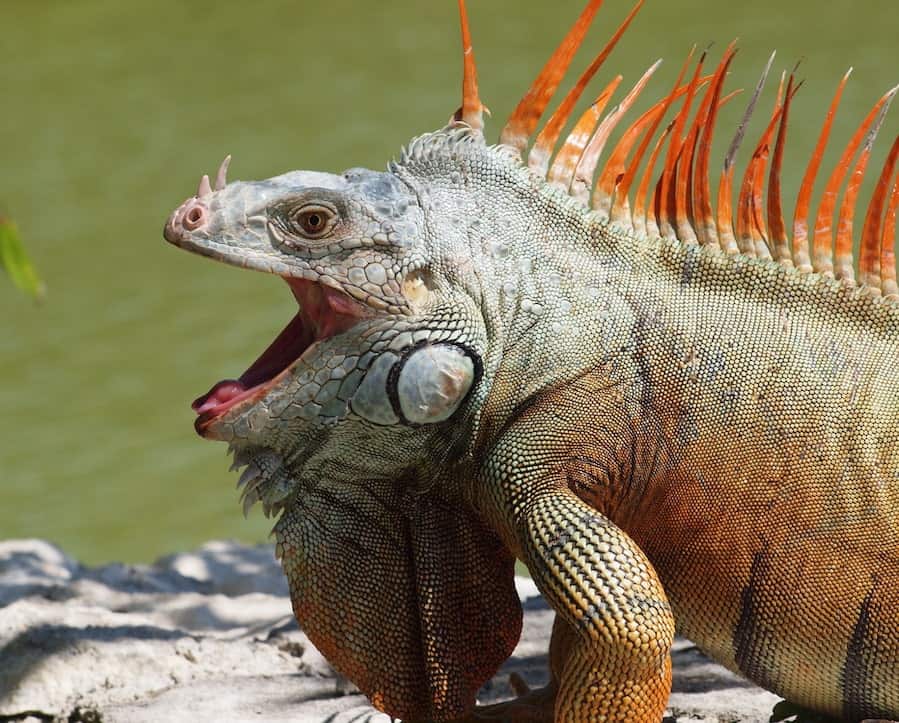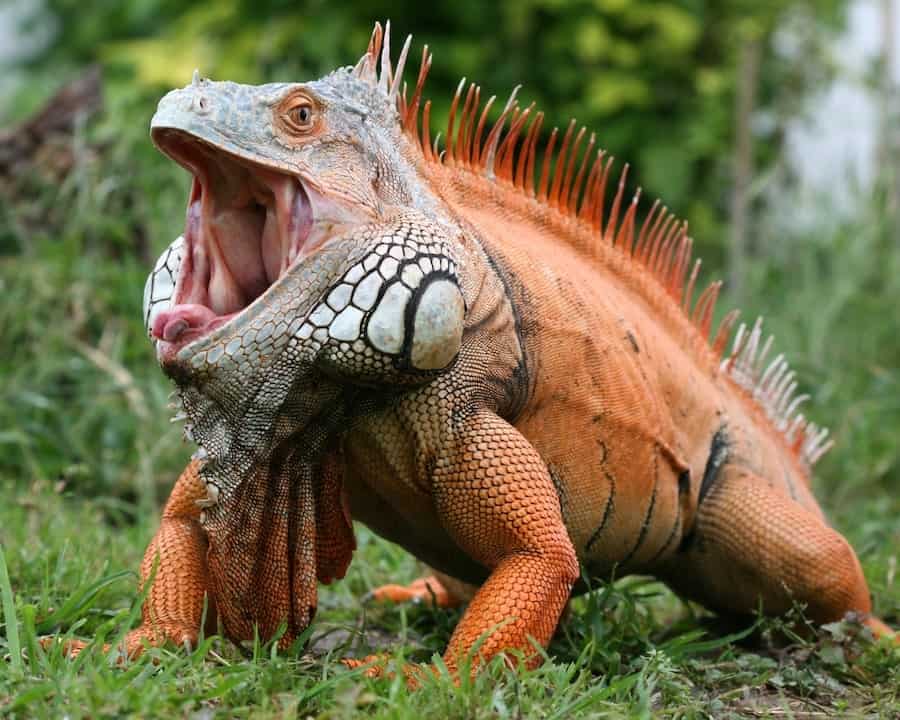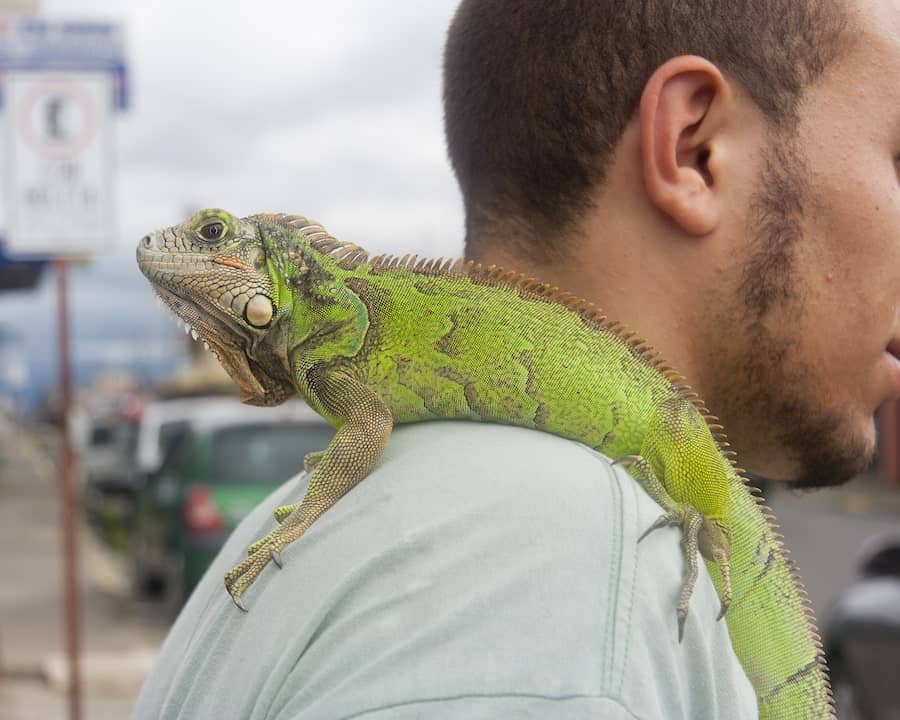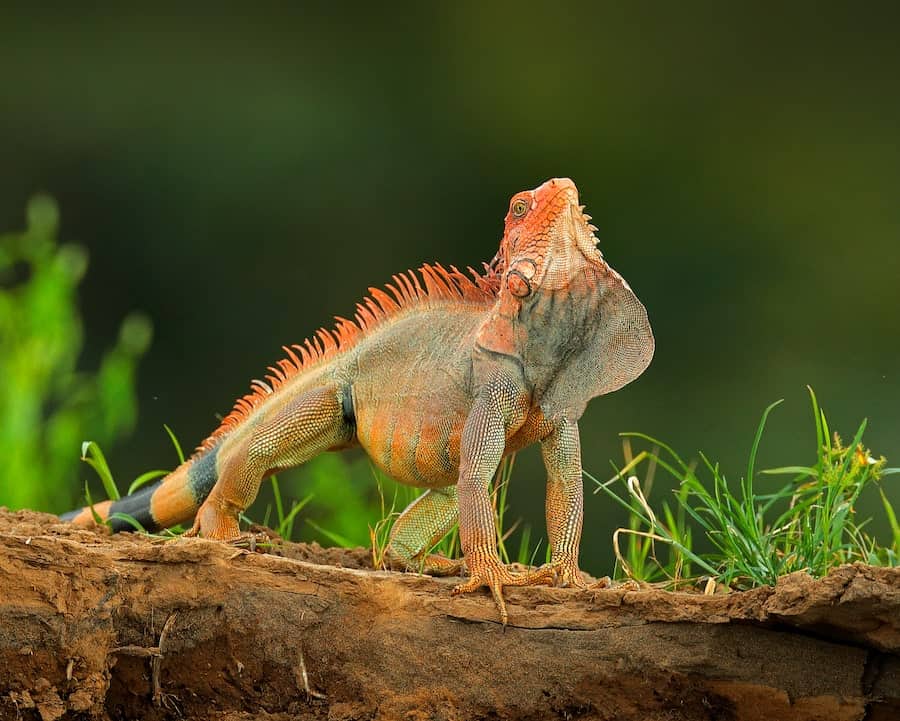Whether you’re about to adopt a pet iguana, or will be visiting a location where feral iguanas are common, its imperative that you learn how to identify an angry iguana.
As a general rule, angry iguanas will stand sideways, inflate their dewlaps, bob their heads, open their mouths, or hiss. They may show just one or a combination of angry signs towards people, iguanas, or other animals as a warning to back away before physically attacking.
To avoid a possible iguana injury, make sure you become adept at interpreting all of the following signs.
1 An Angry Iguana Stands Sideways
Probably the easiest way to tell that an iguana is angry, is the fact that it will stand sideways, giving the impression of a larger animal, and someone you don’t want to mess with.
Standing sideways is usually your first warning, and is coupled with a ready-to-whip stiff tail.
Because standing sideways is the first warning, the iguana is usually not very angry (yet), thus, many people make the mistake of getting too close, resulting in the iguana attacking.
2 An Angry Iguana Inflates Its Dewlap

In an event of a perceived threatening situation, an angry iguana will inflate its dewlap.
According to iguana expert, James W. Hatfield, in his book, “Green Iguana The Ultimate Owner’s Manual,” both male and female iguanas have dewlaps and use them in much the same way. However, males typically boast a larger dewlap.
The dewlap is an extension of the iguana’s skin, located on the underside of the throat, and functions to give off a larger appearance. Thus, hopefully, warding off predators.
However, the dewlap can also be used for:
- Increasing body temperature
- Cooling body temperature
- Demonstrate pecking order
- Display territorial dominance
3 An Angry Iguana Has Its Eyes Wide Open

Since iguanas make no sounds, they’re very visually oriented. They have mostly monocular vision, which is why they have bird like head movements, and tend to use one eye to focus on a their subject.
When an iguana perceives a threat, the pupils will dilate or contract, meaning it is upset. Thus, allowing more light to enter the eye.
Did you know iguanas have a third eye? Read all about it in this post I wrote titled, “Go Iguanas Have 3 Eyes? Everything You Need to Know.”
4 An Angry Iguana Bobs Its Head
Iguana head bobbing can be interpreted in many different ways, which you can read about in more detail via this post I wrote titled, “7 Reasons Why Your Iguana Bobs Its Head.”
However, for simplicity’s sake, the vast majority of head bobs are a result of an upset or angry iguana.
An iguana head bob can be interpreted as:
- Territorial Ownership
- Food Ownership
- Simply Having a Bad Way
- Mate Ownership
- Social Status
- Greeting
- Warning Sign For Other Iguanas
With the exception of greetings, ignoring an iguana head bob will more than likely result in a violent attack.
All iguanas, from hatchlings to mature adults, including males and females, will bob their heads.
However, according to anapsid.org mature males will do it more often, and tend to have a smoother, more controlled head bob.
Female nods are more jerky, almost as if they’re in the process of learning how to head bob.
5 An Angry Iguana Opens Its Mouth

Iguanas contain 80-120 razor sharp pleurodont teeth (attached to the inside of the jawbone) which they replace up to five times a year, and use to tear vegetation into smaller and easier-to-swallow pieces.
Because they replace their teeth so rapidly, it’s not at all uncommon for a medium sized iguana to replace as many as 500 teeth in one year alone!
Although not their primary weapon of choice for proximity reasons, their piranha-like teeth can cause serious damage, and even require a trip to the ER.
Their teeth are so sharp that it’s not uncommon for someone to require stitches after an angry iguana bite.
Luckily, by the time a mad iguana feels the need to bite, you should have received multiple warnings signs, including the iguana turning sideways to appear larger and an open mouth which says “you see all these teeth? I’m not afraid to use them!”
6 An Angry Iguana Will Hiss
On more rare occasions, an open mouth will be combined with a hiss, a sound resulting from iguanas filling their air with lungs and forcefully exerting it through the mouth.
Hissing is a sign of extreme anger, and usually your last warning sign. Therefore, if you get to close, you best believe the iguana will not hesitate to attack.
To learn more about why iguanas hiss and what to do about, check out this post I wrote titled, “Why Iguanas Hiss & What to do About it.”
7 An Angry Iguana’s Tail Will Twitch
According to Iguana Removal 305, an iguana twitches its tail as a sign of confusion, being upset, and, when combined with any of the other signs listed on this post, anger.
Also, the tail twitching may actually not be very twitchy at all. It may be more of a quick wagging, where the tail slightly moves in one direction then back to where it was originally located.
Why do Iguanas Get Mad?
Much like you and I, iguanas have many reasons for getting angry and aggressive.
The following are reasons why an iguana may get mad:
- It feels like it’s life is in danger, and you or another animal may be the culprit
- Territorial reasons
- Another iguana is challenging its dominance
- Protection of its food
- Protecting its mate
- Having a bad day
Is An Angry Iguana Dangerous?

An angry iguana can be very dangerous to both people and other animals, especially fully grown males as they can grow up to 8 feet long and weigh 20 pounds!
I have heard iguana experts claim that a tail whip from an iguana in the right place can break a cat or small dogs’ bones.
However, tail whips aren’t the only cause for concern. Bites, especially from an infected iguana, can prove more dangerous, as they can transmit certain harmful bacteria to other animals and people, and sometimes require stitches.
If you’d like to go more in depth regarding the dangers of an iguana, feel free to read this post I wrote titled, “Are Iguanas Dangerous? Not Your Average Pet,” or keep reading for a short summary.
Razor Sharp Teeth
As previously mentioned, iguanas contain razor sharp teeth used for cutting vegetation into swallowable portions.
However, if threatened, they will not hesitate to use their teeth as a means of defense, which can result in stitches and/or an infection.
Tail Whips

An angry iguana is very likely to tail whip whatever is inducing the stress. Their tails make up the majority of their body length, and is packed with muscle.
Be extra way of tail whips from large iguanas, as they have quite the reach, and can cause bleeding. Like an iguana bite, harmful bacteria can be transmitted via a tail whip, especially if bleeding occurs.
Sharp Claws

Although the primary function is to facilitate climbing, an iguana’ s claws are extremely sharp, and can cause bleeding in its attempt to free itself from your grasp.
From my experience, my iguanas claws are sharper than my cats. They’re so sharp, that they would dig in UNDERNEATH my skin.
When I attempted to pull the iguana away from me, it pulled my skin upwards as well, as it was rooted underneath. Yes, it was very painful.
Harmful Bacteria
The biggest danger from an angry iguana is not a physical act of violence, but what can be transmitted via the bite, scratch, or tail whip.
Harmful bacteria like Salmonella is not uncommon among iguanas, and can be detrimental to certain populations such as:
- Pregnant women
- The elderly
- Very young children
- People with vulnerable immune systems
However, salmonella is not only transmissible via physical contact. Many people have contracted the bacteria from iguana poop.
Therefore, I can’t stress enough how important it is for you to keep your iguana’s cage clean. It’s not only a safety precaution for you, but for your iguana as well, as they aren’t too fond of crappy environments. Pun very intended.
Lastly, I’d like to point out that feral iguanas are more likely to contain Salmonella, as they are more frequently exposed to other wild iguanas.
What to do Around An Angry Iguana?
How you decide to act when an iguana is angry at you will depend on whether the iguana is feral or your pet lizard. One is going to require training and the other does not.
Allow me to explain in more detail.
Feral Iguana

An angry feral iguana should be avoided. You don’t want to risk a physical injury, especially since there is no way to be sure if the iguana is infected with Salmonella or not.
If the feral iguana(s) are on your property and cannot be avoided, call your local pest control company, as they are professionals who will be able to handle the dangerous animals.
Remember, physical contact is not required to contract Salmonella. Any surface or liquids that came into contact by the infected iguana can now transmit the bacteria, and there lies the primary danger.
Pet Iguana

Pet iguanas require different handling when they’re angry, as backing off at the first sign of aggression communicates to your lizard that you are afraid, and he/she can get away with whatever they please.
The only way to tame a new pet, and more than likely, angry iguana is to handle it. The more you handle it, the more calm and docile it will become.
However, forcefully picking up your lizard when its new to your home and displaying signs of aggression is also not the right approach.
According to aforementioned James Hatfield, here is a quick rundown of how you should handle your iguana.
- If you iguana is new to your home, don’t even try to pick him or her up. Just let it get accustomed to your place, sight, and smells.
- Once you can stick your hand inside its cage without the iguana panicking or displaying signs of aggression, it’s time to begin picking it up.
- Try holding it for at least 10-15 minutes a day for two weeks.
- Then, increase the handling to 15-30 minutes once or twice a day.
It’s imperative to monitor your lizard’s stress levels when you begin to handle it, as anger is usually coupled with stress, and stress my induce other unwanted symptoms.
High energy and temporarily changing colors is perfectly okay, but if you notice lethargy, depression, or significant appetite loss, you may want to dial back on the handling, as it’s overloading your iguana with stress.
If you’re reading this post because you’re debating the adoption of a pet iguana, check out this post I wrote titled, “Are Iguanas Good Pets For Beginners? Here’s Why Not.”

